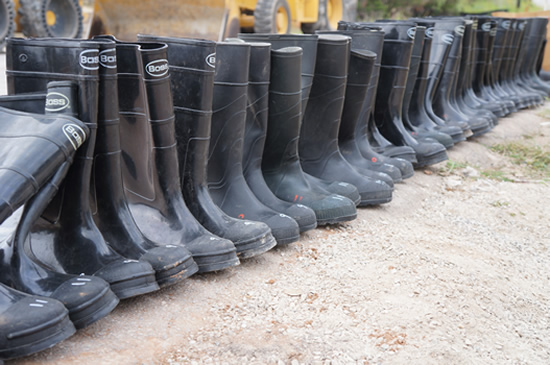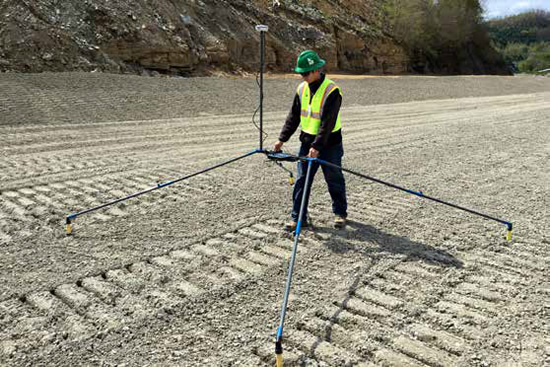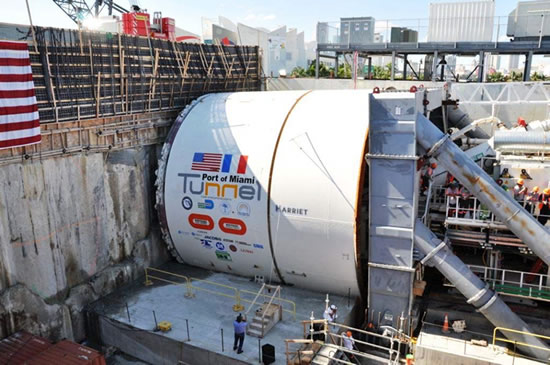The American Society of Civil Engineers has just released the 2017 Report Card on American Infrastructure. As expected, the Society finds that the nation’s current infrastructure is grossly underfunded and in need of significant repair. One of the surprises in the report card—particularly to geosynthetics professionals—is that solid waste management has been downgraded. Solid waste has routinely been the highest-rated sector of American infrastructure, in part because of its requirement to use geosynthetics.
Railways, however, have scored the highest rating for the 2017 Report Card. (Ports have also risen to a level that ranks them alongside the solid waste sector.) See sections below for how the rail sector has passed other sectors and why solid waste is found to be slipping.
Overall, ASCE estimates that the country has a USD $2 trillion, 10-year investment gap and that to “restore our global competitive advantage, we must increase investment from all levels of government and the private sector from 2.5% to 3.5% of U.S. Gross Domestic Product (GDP) by 2025.”
The Report Card is issued every four years. Read the organization’s notes on the positives, negatives, and needs for 16 sectors at the Report Card on American Infrastructure website. The site also allows visitors to review state-by-state performance. An infrastructure report card app is also available in the iTunes App and Google Play stores.

2017 AMERICAN INFRASTRUCTURE GRADES
- Aviation – D (2013: D)
- Bridges – C+ (2013: C+)
- Dams – D (2013: D)
- Drinking Water – D (2013: D)
- Energy – D+ (2013: D+)
- Hazardous Waste – D+ (2013: D)
- Inland Waterways – D (2013: D-)
- Levees – D (2013: D-)
- Ports – C+ (2013: C)
- Public Parks & Recreation – D+ (2013: C-)
- Rail – B (2013: C+)
- Roads – D (2013: D)
- Schools – D (2013: D)
- Solid Waste – C+ (2013: B-)
- Transit – D- (2013: D)
- Wastewater – D+ (2013: D)
Total infrastructure grade for 2017: D+ (2013: D+)

RAILWAYS OVERTAKE SOLID WASTE
The infusion of USD $27 billion in capital investment in the US rail network in 2015 has catapulted the rail sector above solid waste. With 140,000 miles of track and 100,000 bridges in the rail network, the swift move of rail into the top-rated infrastructure sector is no easy feat. It emphasizes the beneficial impact that investment in infrastructure can have.
“Federal forecasts predict an approximately 40% increase in U.S. freight shipments, including by rail, by 2040,” ASCE writes. Indeed, the freight side of rail seems to have benefitted the most from the billions poured into railway improvement. The Society notes that passenger railway is in a worse state, which could impact the sector’s rating in come the next report card, if additional investment is not directed there.
WHY IS SOLID WASTE SLIPPING?
In previous report cards, the solid waste sector has held higher grades. This has been a point of pride in the geosynthetics field, as solid waste is the only sector in which geosynthetics are required. The success of geosynthetics in securing landfills and optimizing the performance and economics of buried waste facilities was a major reason that the EPA moved coal ash storage under Subtitle D’s containment regulations.
So why has solid waste slipped on ASCE’s Report Card on American Infrastructure?
It is not for environmental performance reasons. ASCE finds the sector sufficiently funded and that municipal solid waste facilities operate effectively. BUT, recycling rates have plateaued, and very little new investment has gone into material recovery facilities and waste-to-energy facilities.
“There is a need to change the way we think of how solid waste is generated, managed, and potentially used as a resource,” ASCE writes. “Americans need to recognize that what is routinely discarded may in fact be a reusable resource.”
The Society also notes that waste management suffers to some extent because of other infrastructure sectors performing poorly.
“Solid waste management is inherently tied to the proper functioning of other infrastructure, such that without fully-functioning transportation options—roads, bridges, rail, inland waterways—solid waste collection is compromised with the resulting impacts to public health.”
The Solid Waste Sector Analysis is available here. (PDF)

GEOSYNTHETICS IN AMERICAN INFRASTRUCTURE
Geosynthetics continue to have a beneficial impact on infrastructure. We highlight some of those areas below.
Bridges – FHWA’s Every Day Count initiative has had a substantial, beneficial impact on the vast network of smaller bridges in the country that are frequently overlooked in infrastructure discussions. Media tends to focus on major bridges in densely populated areas, but small bridges, which are frequently the responsibility of counties, constitute the majority of bridges. They are vital links between communities and service the transport of manufactured goods and agricultural production. FHWA, through the EDC program, has promoted the quicker construction and lower cost of the Geosynthetic Reinforced Soil – Integrated Bridge System (GRS-IBS). As recently as January 26, 2017, FHWA has written that “GRS-IBS may save up to 60 percent in cost compared to a standard DOT bridge, and the system potentially requires less or simpler life-cycle maintenance.”
Coal Ash – Up through the 2005 ASCE report card, coal ash had not been heavy concern, from an infrastructure analysis perspective; but the 2008 failure of a coal ash tailings containment cell in Tennessee led ASCE to highlight the poor state of dams in its 2009 Report Card. The Society wrote at the time, “The 2008 failure of a dam retaining coal ash from a power plant in Tennessee points out significant gaps in the regulation of dams associated with the power and mining industry at both the federal and state levels.” The US responded by placing coal combustion residual storage and handling under the Subtitle D regulations that since the 1980s have produced steady, successful gains in performance by the solid waste sector. Over the next decade, these regulations will see coal ash cells capped, rehabilitated, or constructed new with geosynthetics. Geosynthetic companies, for example, have developed drainage composites specifically for coal ash.
Energy – Geosynthetic containment designs are correcting the handling of coal combustion residuals from more traditional utility operations. Geosynthetics are also supporting the growth of more sustainable wind energy. ASCE notes that perhaps the biggest challenge facing renewable energy generation is the efficiency by which that power can be fed into the larger grid. Wind energy, for example, is generally produced in remote areas and much of that energy is lost in transmission. Still, geosynthetics are making the construction of wind energy farms far more efficient while reducing environmental impact. Engineers must now focus on improving transmission technologies so that renewables are better supported in the long-term energy grid.
Roads & Rails – Geosynthetics have had substantial impact on the performance of roadways and railways. Geotextiles and geogrids have greatly improved flexible pavement system performance, enhanced drainage, and extended system service lives while reducing maintenance needs. In Alaska, for example, geotextiles have halted the development of frost boils along a highway over many years. In both road and rail applications, geogrids and geotextiles can reduce the overall need for aggregate (which reduces costs and labor time and improves project sustainability ratings) and strengthen the overall system.
Solid Waste – As noted above, the solid waste industry is the most versed in understanding how to design with, select, install, and monitor geosynthetic systems. While material reuse rates are drag on the solid waste sector’s overall performance, we must not overlook ways in which current buried waste cells can be improved. The utilization of electrical leak location and affiliated CQA strategies can yield even higher rates of efficiency and environmental performance for solid waste cells. Geosynthetic caps combined with LFG systems can significantly improve the amount of methane captured and converted, making landfills powerful, beneficial energy resources for their communities.
Water infrastructure – After Hurricane Katrina reaped extraordinary damage in and around New Orleans, the levee system began a substantial upgrade—much of it constructed with geosynthetic reinforcement, drainage, and soil consolidation materials that were not available when the old levee system was built. With geosynthetic support, these levees can be built taller and more efficiently. It’s an approach that can be utilized in more areas of the country. Also of note, the 2014 passage of the Water Resources Reform and Development Act (WRRDA), specific mention was made for the US Army Corp of Engineers to consider “durable, resilient, and sustainable materials and practices, including the use of geosynthetics, advanced composites, and innovative technologies” in carrying out its work. The benefits here can improve water-related sectors rated by ASCE, such as levees, dams, and inland waterways. For ports, geosynthetics are providing scour protection, dewatering, erosion control, and other solutions—such as making tunnel construction more efficient. The Port of Miami project serves as a wonderful example.













Interesting Read, Chris!